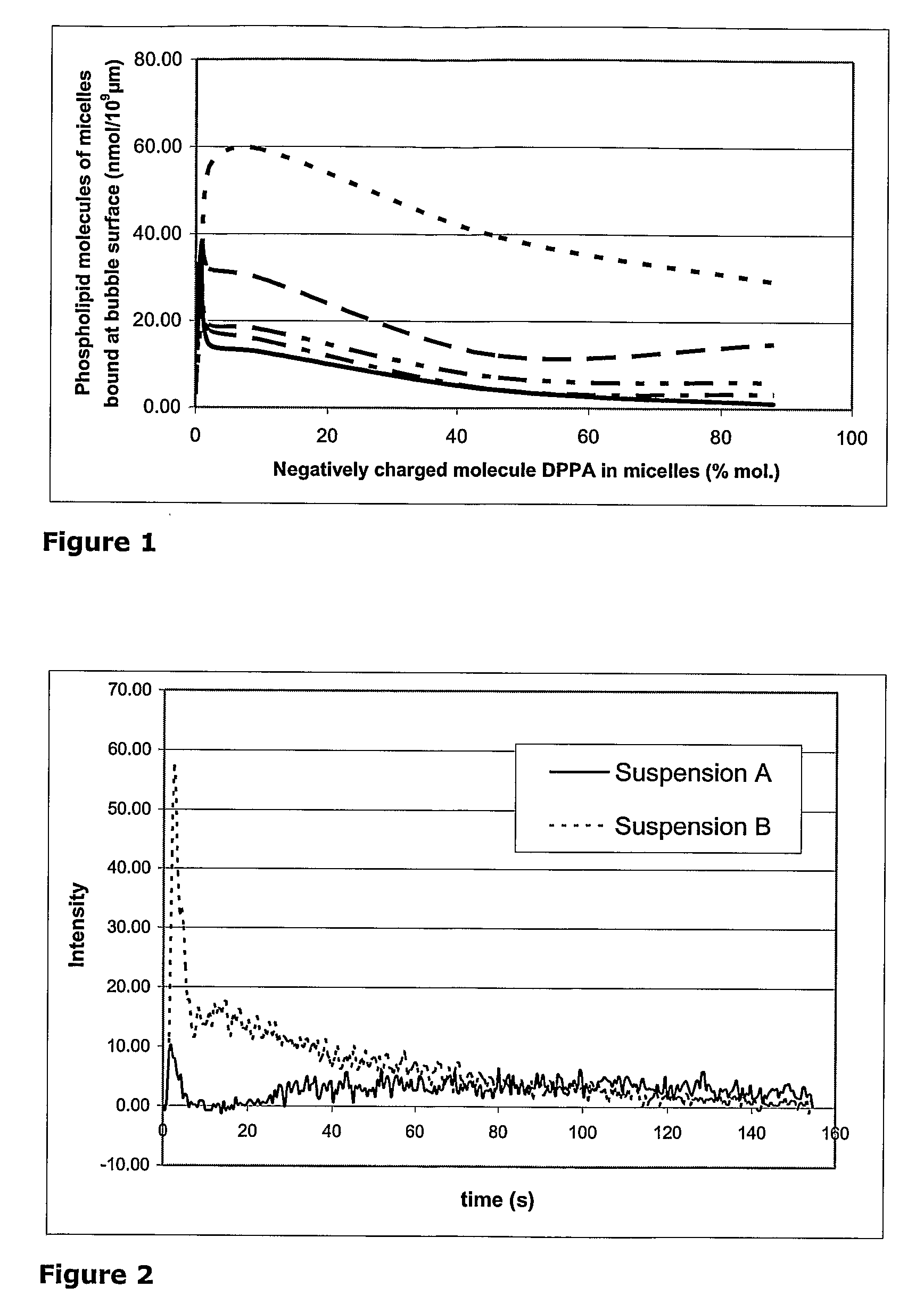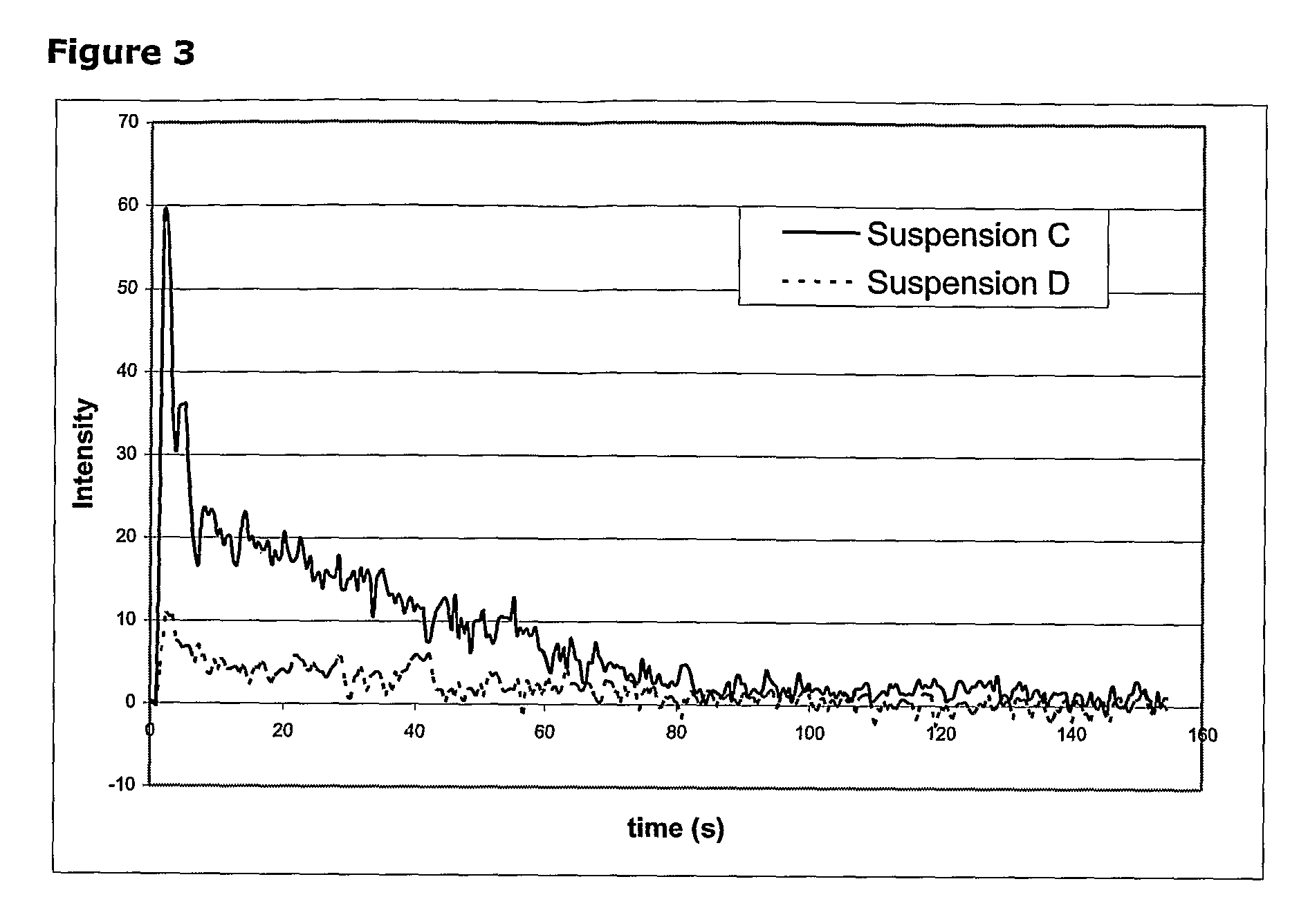Gas-filled microvesicle assembly for contrast imaging
a technology of contrast imaging and microvesicle, which is applied in the field of gas-filled microvesicle assembly for contrast imaging, can solve the problems of limited practical interest in the simple dispersion of free gas bubbles in the aqueous medium, and achieve the effect of increasing pressure resistance and extreme flexibility in preparation
- Summary
- Abstract
- Description
- Claims
- Application Information
AI Technical Summary
Benefits of technology
Problems solved by technology
Method used
Image
Examples
example 1
[0241] Preparation of Positively Charged Microballoons
[0242] Tripalmitin (60 mg) is dissolved in cyclohexane (0.6 ml) at 40° C. This organic phase is kept at 40° C. until emulsification. 40 mg of Ethyl-SPC3 (cationic phospholipid) are dispersed in 30 ml of distilled water at 65° C. for 15 min and then the dispersion is allowed to cool to 40° C.
[0243] The organic phase is emulsified in the aqueous phase using a Polytron® homogeniser PT3000 (10000 rpm, 1 min). The emulsion is then diluted with 5 ml of PVA (200 mg, Mw: 9000 from Aldrich) in distilled water, then cooled to 5° C., frozen at −45° C. for 10 min and then lyophilized (0.2 mbar, 24 h).
[0244] The lyophilisate is redispersed in distilled water (20 ml) in the presence of air, microballoons are washed twice by centrifugation (600 g for 10 min) with phosphate buffered saline and the final suspension of microballoons (20 ml). The size characterization for this preparation gave the following results: DV50=2.54 μm; DN=1.57 μm.
example 1a
[0245] Preparation of Fluorescent Marked Positively Charged Microballoons
[0246] Example 1 is repeated by adding 5% by weight (with respect to the total weight of tripalmitin) of lipophilic fluorescent probe DIO18 in the organic phase for fluorescently marking the microballoon. The size characterization for this preparation gave the following results: DV50=2.38 μm; DN=1.45 μm.
examples 2a-2e
[0247] Preparation of DSTAP-Containing Positively Charged Microbubbles
[0248] 15 mg of a mixture of DAPC and cationic lipid DSTAP (see relative ratio in table 1) and 985 mg PEG4000 are dissolved in tert-butanol (10 ml) at 50° C. The solution is sampled in 10 ml vials (50 mg of dry matter per vial) then freeze dried in a Christ Epsilon 2-12DS freeze dryer (−30° C., 0.56 mbar for 24 h). After additional drying (25° C., 0.1 mbar for 5 hours), the vials are stoppered with an elastomeric stopper and sealed with an aluminium flip off.
[0249] The obtained lyophilisates are exposed to the desired gas (50:50 v / v of C4F10 / N2) and then redispersed in 5 ml of the PBS buffer solution thus obtaining a suspension of positively charged microbubbles. Size characterization of suspended microbubbles is reported in table 1.
TABLE 1DSTAP-containing microbubblesDAPC / DSTAPExamplemolar ratioDVDN2a99:1 8.573.112b95:5 8.641.732c90:108.801.772d80:209.221.822e50:508.511.94
PUM
 Login to View More
Login to View More Abstract
Description
Claims
Application Information
 Login to View More
Login to View More - R&D
- Intellectual Property
- Life Sciences
- Materials
- Tech Scout
- Unparalleled Data Quality
- Higher Quality Content
- 60% Fewer Hallucinations
Browse by: Latest US Patents, China's latest patents, Technical Efficacy Thesaurus, Application Domain, Technology Topic, Popular Technical Reports.
© 2025 PatSnap. All rights reserved.Legal|Privacy policy|Modern Slavery Act Transparency Statement|Sitemap|About US| Contact US: help@patsnap.com


